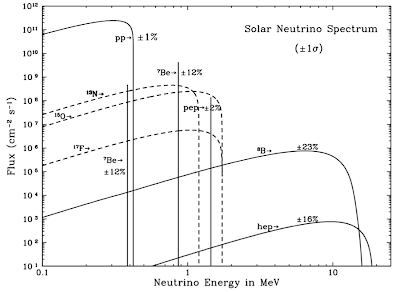Neutrino Astrophysics: Rationale and production
, 2 min, 399 words
Tags: physics neutrinos astrophysics
This is the first in a series of posts about neutrinos and astrophysics. Other neutrino-related posts can be found here.
At first, neutrinos seem like puzzling particles; they interact only by the weak force, carry almost no mass, and seem insignificant to the grand scheme of things. On the contrary, they've played a fundamental role in the evolution of the Universe, and are a uniquely powerful tool in our understanding of certain astrophysical phenomena. This is precisely because of their low interaction rates; they can propagate effortlessly through optically thick material and bring us information that light cannot.
As you may know, there are three types of neutrinos, the electron, muon, and tau flavors, which correspond to specific leptons. There are a variety of neutrino sources. The nearest and most accessible is the Sun, which sends neutrinos to us at a rate of around a billion per square centimeter per second. Then there are energetic events like supernovae and gamma ray bursts, which provide short-lived fluxes of neutrinos. There's also this thing called the cosmic neutrino background, which is analogous to the cosmic microwave background. Finally, there are atmospheric neutrinos, which are produced by cosmic ray interactions with the atmosphere.
In order to discuss neutrino detection, it is beneficial to examine the largest source of neutrinos in our neighborhood: fusion in the center of the Sun (discussed in much greater depth in the post here). The plot below shows the neutrino flux as a function of its energy as a result of various steps in hydrogen fusion.

The solid lines show neutrino fluxes versus the energy of the produced neutrinos for various steps in the proton proton chain. In particular, the lowest-energy neutrinos shown (the spike on the left) are produced in the first step of the pp chain, while the other reactions, like boron-8 and He-p fusion, occur in only a small fraction of solar fusion reactions. The dashed lines show predicted neutrino fluxes from the CNO cycle, which isn't terribly relevant to the Sun, since its core is too cool for the CNO cycle to function.